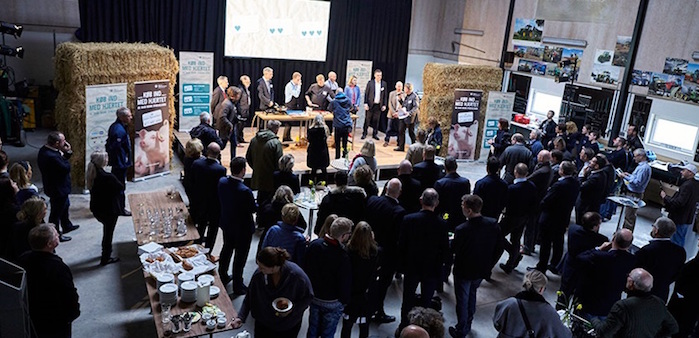Just 6% of Danish consumers make decisions on buying pork on the basis of animal welfare, according to a survey commissioned by the Danish Agriculture and Food Council (DAAC).
A new Government-backed welfare label based on a three-tier labelling scheme run by the Danish government, some supermarkets and the DAAC is being launched at the end of May (the picture above shows the March launch event, credit: Peter Prik Larsen).
Called Better Animal Welfare, its aim is to raise the welfare standards at Danish farms and provide consumers with greater transparency.
Prior to the launch, the DAAC said the standard of animal welfare was not currently evident from a packet of meat sold in a supermarket. The new label will help consumers gain a better insight into the production conditions that went into producing the meat, it said.
“The aim is to inform consumers about the conditions under which the animals were kept during primary production. New surveys from the Danish Agriculture and Food Council show that two out of three consumers in Denmark wish to be better informed about animal welfare during their supermarket shopping,” the DAAC said.
It cited an EU survey ‘revealing that the Danes are particularly willing to pay extra for animal welfare-friendly products’. Only consumers in Sweden, Holland and Luxembourg show a greater willingness to do so, the DAAC said.
Despite this high level of willingness, the reality is different when consumers come to make their shopping choice, according to a new survey carried out by Gallup on behalf of the council.
A total of 2,982 Danes were asked what criteria they used to make their most recent purchase and just 6% cited animal welfare as one of the parameters.
“Danes currently opt for meat from Denmark when they want meat that carries good animal welfare credentials. But ‘Danish՚ covers many qualities other than welfare, for example, food safety and short transport times,” the DAAC added.
About the new welfare label
The label is a three-tiered scheme whereby meat that meets the most rigorous requirements carries three hearts. lt is based on five basic pig production requirements, which exceed current legislative requirements. In order to qualify for it, farmers must comply with the following criteria:
- Sows must be loose-housed;
- The pigs must have curly tails – no tail docking and no tail biting;
- More straw for rooting and manipulable material and for nest building;
- More space;
- Maximum transport time – 8 hours




